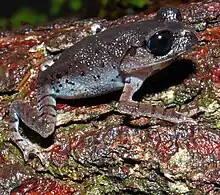Eastern spadefoot toad
Eastern spadefoot toads (Leptobrachium, also known as large-eyed litter frogs[1]) comprise a genus of the family Megophryidae in the order Anura, and are found in southern China, northeast India, southeast Asia, and islands of the Sunda Shelf as well as the Philippines.[2] They are characterized by a stocky body with slender, short hindlimbs.[3] In identifying species, iris colour is a valuable diagnostic morphological characteristic (see Leptobrachium bompu for an example of a blue-eyed species); the iris has uniform colour in some species, whereas in other species the upper half is coloured and the lower half is dark.[4]

| Eastern spadefoot toads | |
|---|---|
 | |
| Leptobrachium hasseltii | |
| Scientific classification | |
| Domain: | Eukaryota |
| Kingdom: | Animalia |
| Phylum: | Chordata |
| Class: | Amphibia |
| Order: | Anura |
| Family: | Megophryidae |
| Genus: | Leptobrachium Tschudi, 1838 |
| Type species | |
| Leptobrachium hasseltii Tschudi, 1838 | |
| Species | |
|
About 35, see text. | |
The sister taxon of Leptobrachium is a clade that includes Scutiger and Oreolalax.[2][6]
Subgenera
Two subgenera, Leptobrachium and Vibrissaphora, are recognized; the latter was originally described as a genus, with Vibrissaphora boringii as the type species.[2] These subgenera (or genera) were originally separated by presence (in Vibrissaphora, hence the common name moustache or spiny toad) and absence of nuptial spines on the upper labium in males during the breeding season (in Leptobrachium). Later genetic analyses have not supported this original separation, but still indicate the presence of two distinct clades. These clades can be referred to as subgenera Leptobrachium and Vibrissaphora, but their contents differ from the earlier, purely morphological definition (Vibrissaphora contains all spiny species, but also non-spiny ones). Subgenus Vibrissaphora thus defined is distributed in southern China and Indochina, and subgenus Leptobrachium in the Malay Peninsula and the Malay Archipelago northwest of the Wallace Line.[4] No morphological character that could uniquely separate the subgenera has yet been identified.[7]
Species
As of mid-2019, there were 36 recognized species:[2] and one proposed species
- Leptobrachium abbotti (Cochran, 1926)
- Leptobrachium ailaonicum (Yang, Chen, and Ma, 1983)
- Leptobrachium banae Lathrop, Murphy, Orlov & Ho, 1998
- Leptobrachium bompu Sondhi & Orlov, 2011[8]
- Leptobrachium boringii (Liu, 1945)
- Leptobrachium buchardi Ohler, Teynié & David, 2004[9]
- Leptobrachium chapaense (Bourret, 1937)
- Leptobrachium guangxiense Fei, Mo, Ye & Jiang, 2009
- Leptobrachium gunungense Malkmus, 1996
- Leptobrachium hainanense Ye & Fei In Ye, Fei & Hu, 1993
- Leptobrachium hasseltii Tschudi, 1838
- Leptobrachium hendricksoni Taylor, 1962
- Leptobrachium huashen Fei and Ye, 2005
- Leptobrachium ingeri Hamidy, Matsui, Nishikawa, and Belabut, 2012
- Leptobrachium kanowitense Hamidy, Matsui, Nishikawa, and Belabut, 2012
- Leptobrachium kantonishikawai Hamidy and Matsui, 2014
- Leptobrachium leishanense (Liu and Hu, 1973)
- Leptobrachium leucops Stuart, Rowley, Tran, Le & Hoang, 2011[10]
- Leptobrachium liui (Pope, 1947)
- Leptobrachium lumadorum Brown, Siler, Diesmos & Alcala, 2010
- Leptobrachium mangyanorum Brown, Siler, Diesmos & Alcala, 2010
- Leptobrachium masatakasatoi Matsui, 2013[7]
- Leptobrachium montanum Fischer, 1885
- Leptobrachium mouhoti Stuart, Sok & Neang, 2006
- Leptobrachium ngoclinhense Orlov, 2005
- Leptobrachium nigrops Berry & Hendrickson, 1963
- Leptobrachium promustache (Rao, Wilkinson, and Zhang, 2006)
- Leptobrachium pullum (Smith, 1921)
- Leptobrachium rakhinensis Wogan, 2012
- Leptobrachium smithi Matsui, Nabhitabhata & Panha, 1999
- Leptobrachium sylheticum Al-Razi, Maria, and Poyarkov, 2021[11]
- Leptobrachium tagbanorum Brown, Siler, Diesmos & Alcala, 2010
- Leptobrachium tenasserimense Pawangkhanant, Poyarkov, Duong, Naiduangchan, and Suwannapoom, 2018
- Leptobrachium tengchongense Yang, Wang, & Chan, 2016
- Leptobrachium waysepuntiense Hamidy & Matsui, 2010[12]
- Leptobrachium xanthops Stuart, Phimmachak, Seateun & Sivongxay, 2012[13]
- Leptobrachium xanthospilum Lathrop, Murphy, Orlov & Ho, 1998
References
- Wild Borneo: The Wildlife and Scenery of Sabah, Sarawak, Brunei, and Kalimantan. New Holland Publishers. 2006. p. 69. ISBN 1845373782.
- Frost, Darrel R. (2017). "Leptobrachium Tschudi, 1838". Amphibian Species of the World: an Online Reference. Version 6.0. American Museum of Natural History. Retrieved 25 June 2017.
- Matsui, Masafumi; Jarujin Nabhitabhata; Somsak Panha (1999). "On Leptobrachium from Thailand with a description of a new species (Anura: Pelobatidae)". Japanese Journal of Herpetology. 18 (1): 19–29. doi:10.5358/hsj1972.18.1_19.
- Matsui, M.; Hamidy, A.; Murphy, R. W.; Khonsue, W.; Yambun, P.; Shimada, T.; Ahmad, N.; Belabut, D. M.; Jiang, J. P. (2010). "Phylogenetic relationships of megophryid frogs of the genus Leptobrachium (Amphibia, Anura) as revealed by mtDNA gene sequences". Molecular Phylogenetics and Evolution. 56 (1): 259–272. doi:10.1016/j.ympev.2010.03.014. PMID 20302957.
- Hudson, C. M.; Fu, J. (2013). "Male-biased sexual size dimorphism, resource defense polygyny, and multiple paternity in the Emei moustache toad (Leptobrachium boringii)". PLOS ONE. 8 (6): e67502. Bibcode:2013PLoSO...867502H. doi:10.1371/journal.pone.0067502. PMC 3696078. PMID 23840725.
- Pyron, A. R.; Wiens, J. J. (2011). "A large-scale phylogeny of Amphibia including over 2800 species, and a revised classification of extant frogs, salamanders, and caecilians". Molecular Phylogenetics and Evolution. 61 (2): 543–583. doi:10.1016/j.ympev.2011.06.012. PMID 21723399.
- Matsui, M. (2013). "A new Leptobrachium (Vibrissaphora) from Laos (Anura: Megophryidae)". Current Herpetology. 32 (2): 182–189. doi:10.5358/hsj.32.182. hdl:2433/216851. S2CID 85577993.
- Sondhi, S.; Orlov, A. (2011). "A blue-eyed Leptobrachium (Anura: Megophryidae) from Arunachal Pradesh, India" (PDF). Zootaxa. 2912: 28–36. doi:10.11646/zootaxa.2912.1.2.
- Ohler, A.; Teynié, A. & David, P. (204). "A green-eyed Leptobrachium (Anura: Megophryidae) from southern Laos" (PDF). Raffles Bulletin of Zoology. 52 (2): 695–700. Archived from the original (PDF) on 2012-03-16.
- Stuart, B. L.; Rowley, J. J.; Tran, Dao T. A.; Le, Duong T. T. & Hoang, H. D. (2011). "The Leptobrachium (Anura: Megophryidae) of the Langbian Plateau, southern Vietnam, with description of a new species" (PDF). Zootaxa. 2804: 25–40. doi:10.11646/zootaxa.2804.1.3.
- "Leptobrachium sylheticum Al-Razi, Maria, and Poyarkov, 2021 | Amphibian Species of the World".
- Hamidy, A.; Matsui, M (2010). "A new species of blue-eyed Leptobrachium (Anura: Megophryidae) from Sumatra, Indonesia" (PDF). Zootaxa. 2395: 34–44. doi:10.11646/zootaxa.2395.1.3.
- Stuart, B. L.; Phimmachak, S.; Seateun, S.; Sivongxay, N. (2012). "A new Leptobrachium (Anura: Megophryidae) from the highlands of southeastern Laos" (PDF). Zootaxa. 2155: 29–37.